How To Choose Auto Insurance That Fits Your Needs
Choosing auto insurance that fits your needs means considering risk and what you can afford in premiums and out-of-pocket after an accident. Your agent can help you decide what types of coverage to buy and the limits you need. Visit Insurance Springdale AR for more information
Standard auto policies include bodily injury liability, collision, comprehensive, and uninsured/underinsured motorist coverage. Consider a deductible option and usage-based insurance options.

The auto insurance policy you purchase provides a variety of coverages. The policy’s declarations page lists the full legal name of the insurer, your name and address, the effective and expiration dates, the premium payable, the amount and types of coverage provided, the deductibles, and the vehicle(s) insured. This is a document that should be carefully read.
Coverage includes liability protection to pay for injuries to third parties if you are found responsible for an accident. It also covers the cost of damage to their property. Medical payment coverage pays for medical expenses for you and your passengers regardless of who is at fault in an accident. This is a mandatory coverage. Uninsured motorists protection, which is also required by law, pays for your bodily injury if an uninsured or hit-and-run driver hits you.
Additional coverages include collision, which pays to repair your car if you collide with another object or rollover. Comprehensive, which provides reimbursement for damage from inclement weather, vandalism, and animals, may also be included. Rental car reimbursement coverage pays for a rental car if your car is in the shop due to a covered claim.
Many companies offer discounts for a variety of reasons. For example, safe driving records can reduce your premium, as can having a good credit history. Some companies even give lower rates to people who buy both auto and home insurance through them. Other ways to save on your premium include a multi-car discount, antitheft devices, and being a carpool member. Most states allow insurance companies to factor in customers’ credit information when determining their rates. Some, like
A variety of factors determine the cost of auto insurance. These include the cost of litigation, medical care, car repair, weather patterns, and fraud trends. Other factors include the driver’s age, driving history, and gender. Younger drivers generally pay more for auto insurance than older drivers, and women tend to have fewer accidents than men.
Your insurance agent, broker, or insurance company can provide you with a quote of the total cost of your policy before it is purchased. You can buy it at that time or wait until your renewal date. Some people may get discounted rates when they sign up for a policy with their employer.
During the application process, your insurer can run a credit report and Department of Motor Vehicle record to determine whether you’ll be accepted for coverage. You must provide an official license copy to complete the application process.
Once your application is approved, you can typically begin making payments immediately. You can pay online, update your billing information, or even cancel your auto insurance anytime. However, your insurer must give you a 15-day notice before terminating your policy.
If you’re concerned about your auto insurance history, check with your state’s Department of Motor Vehicles for information on past policies, or call LexisNexis for a CLUE report. This report, which costs $15, provides you with your claim and violation history. It’s also an excellent way to determine how much your premium will change when you claim or add a new driver. This will help you prepare for future auto expenses and make the most informed decision about your car insurance.
Car insurance is designed to help drivers cover expenses associated with an accident. To access these benefits, you will need to file a claim. When you submit a claim, your insurance company will assign it a claims number. From there, it will begin investigating your accident to determine the extent of your damages. They will likely interview all parties involved, request copies of medical records and receipts for lost wages, and inspect the accident scene to gather evidence like photos, videos, and witness testimony.
Depending on your policy details, your claims may be paid out under different sections of your policy. For example, your car insurance policy may have no-fault and liability coverage for property damage and bodily injury. In some states, you can purchase additional protection, such as uninsured/underinsured motorist coverage, personal injury protection (PIP), and medical payments coverage.
If you are involved in an accident that was not your fault, you must claim the other driver’s liability insurance. This is called a third-party claim. If someone else crashed into you, you would file a claim against their PIP or medical payments insurance, depending on your state’s laws.
When submitting a claim, stating the facts clearly and honestly is important. It is not the time to speculate about what happened or to accept blame. It would be best if you also took the time to photograph any damage done to vehicles, property, or people at the accident scene. It is also helpful to get the names, phone numbers, and insurance information of everyone at the scene, including any witnesses. Also, note each vehicle’s direction and traffic signs, if applicable.
An auto insurance exclusion is a clause that removes someone from the policy, typically because they are considered too high-risk to be insured. For example, suppose you have a spouse with a shaky driving history or children with multiple moving violations, at-fault accidents, or claims on their record. In that case, excluding them from your policy may be more cost-effective than trying to keep them on it. In some cases, insurers include exclusions in their policies to prevent fraud. If an excluded driver causes an accident, the driver cannot collect on the policyholder’s liability coverage, but they can sue for damages.
Another common exclusion is for a person who uses the car without permission from the policyholder. This type of exclusion usually applies to teenagers and younger adults who have their cars and are not listed on the policy. This may be a reasonable option for older people since they will likely only drive their vehicles a little anyway. However, if you lend your vehicle to a friend or family member, you must know whether your insurance covers this. If it isn’t, consider getting a separate car insurance policy for this individual.
Also, many policies exclude vehicle use for business purposes, though this may vary by insurer. This includes using a vehicle for the public transportation of people – like a taxi, limo, or shuttle; transportation of goods for payment, such as a delivery driver or a limo, or for any other commercial use not listed on the policy. Suppose you’re in an accident caused by an excluded driver. In that case, it may be more difficult to recover damages because the injured party will need to pursue legal action against the person driving the vehicle at the time of the accident.
Many states have minimum requirements for car insurance. These requirements are usually for bodily injury liability and property damage coverage. Bodily injury liability coverage pays for medical expenses and loss of income if you are at fault in an accident. Property damage coverage pays for repairs to your vehicle or belongings if someone else is at fault in an accident. There are also optional auto coverages that can provide additional protection. These coverages can include rental reimbursement, towing, and roadside assistance.
The policy summary explains what each type of coverage does and how it is included in your policy. It also tells you the deductibles and limits for each coverage. If you have questions, call your agent or broker. It is important to keep your policy up-to-date. Let your agent or broker know when you have a change in driver, a new vehicle, or your financial situation. If you want to cancel the policy, send a written notice with certified mail and the return receipt requested.
Meeting the minimum state requirements is important, but you should consider adding coverages to protect yourself and your family. An independent insurance agent will work with you to determine the best coverage mix. They can help you find affordable policies that fit your needs and budget. They can also help you avoid buying insurance that you don’t need. For example, a basic policy does not include collision and comprehensive coverage, but these are important add-ons if you own your car outright or have a loan. They are also necessary if you lease or finance your vehicle. These coverages will make your vehicle more attractive to potential buyers or lenders.
What You Need to Know About a Residential Mortgage
Whether you are planning to purchase your first home, move to a bigger home, or downsize to a smaller home, a residential mortgage can help you achieve your dream of home ownership. However, it is important to understand the different types of loans available and their differences to find the right financing for your situation.
 Getting a good LTV ratio is important if you’re planning to purchase a home. This ratio helps lenders decide whether to offer you a mortgage loan and what interest rate to charge. A lower ratio can help save you money over the life of the loan. In addition, a lower LTV may make it easier to get a home equity loan later on. LTV ratios are calculated using the appraised value of your home. Homes can appraise for more than their contract price, so you should always check with your real estate agent and your lender before you sign a contract to buy a home. If the appraisal value exceeds the contract price, you may have to pay more cash at closing.
Getting a good LTV ratio is important if you’re planning to purchase a home. This ratio helps lenders decide whether to offer you a mortgage loan and what interest rate to charge. A lower ratio can help save you money over the life of the loan. In addition, a lower LTV may make it easier to get a home equity loan later on. LTV ratios are calculated using the appraised value of your home. Homes can appraise for more than their contract price, so you should always check with your real estate agent and your lender before you sign a contract to buy a home. If the appraisal value exceeds the contract price, you may have to pay more cash at closing.
In general, lenders prefer borrowers with a low LTV ratio, but there are exceptions. In some cases, lenders will approve borrowers with a high LTV ratio, as long as the borrower has a high income and low debt. Choosing to make an overpayment on your residential mortgage may seem like a good idea, but there are some important factors to consider. You need to know that an overpayment will reduce your monthly repayments and that it will not be a tax deduction. There are also some penalties for overpayments, and you need to weigh the benefits against the costs.
Depending on your lender, you can overpay 10% of your loan balance annually. Overpayments can reduce the amount of interest you pay, but it also reduces your loan-to-value ratio. This makes you more likely to qualify for cheaper mortgage deals. If you want to make an overpayment, contact your lender and see the terms and conditions. Some lenders set a cap on overpayments and charge a fee for overpayments, while others allow you to overpay unlimited amounts. Depending on your mortgage product, you may even be able to repay the overpayments.
Whether you’re purchasing a new home, or refinancing your existing home, the TILA-RESPA Integrated Disclosure (TRID) rule may have changed the way you close a residential mortgage. The rule, which the Consumer Financial Protection Bureau implemented in 2010, combines four required disclosures from both TILA and RESPA into a single Closing Disclosure that must be provided to borrowers within three business days of the transaction’s consummation.
According to a recent study by ClosingCorp, a leading mortgage technology provider and closing cost data, the TRID rule has affected how consumers understand and pay for closing costs. While more than half of respondents said that they were able to understand closing costs more clearly in their most recent experience, almost as many respondents said that they experienced more surprises in their most recent experience. In addition, more than 70 percent of respondents said that transaction closing was faster this time around. The study also found that a majority of respondents were prepared for closing costs because of the new forms.
There are a couple of advantages to a mortgagee who purchases his/her own home. One is that they are able to buy a bigger house than someone could afford if they were refinancing their current mortgage. The amount of money required to repay the loan depends on the value of the mortgaged property. Usually, the higher the value, the more money will be needed to repay the loan. Another advantage is that, unlike loans from friends or family, there are no ties to a specific family member or job status.
On the other hand, there are also some disadvantages to a mortgage. The primary disadvantage of this type of loan is that the interest rate you will receive depends on the prime rate, which is usually set by the Bank of America. In addition, since you are selling your home, you will have to deal with real estate taxes and insurance. Also, if you need the funds to pay for certain bills or emergency situations, you may not qualify for a fixed-rate mortgage, because there are certain limits to how low your interest rate can go. Another con to this type of mortgage is that many mortgage companies do not offer financing, so it takes extra work to find one.
Cash Out Refinance
Cash Out Refinance Texas is a type of refinancing in which you receive a loan against property that you already own. The amount of this loan is higher than the cost of the transaction and any existing liens or expenses. This type of refinancing is typically used by borrowers with good or excellent credit.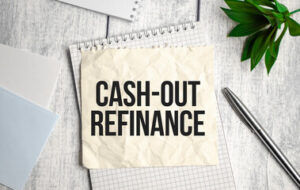
Choosing a cash-out refinance requires careful consideration of your future financial situation. For example, you may wish to consider whether your future career prospects will allow you to keep up with large monthly payments. Missing payments can have negative consequences on your credit score and could even cost you your home. You should also carefully consider the value of the lump sum you’ll be receiving from the loan.
The lender may require that you’ve held legal title to your property for six months or more before applying for a cash-out refinance. This is to ensure that your new loan does not exceed your initial investment in the property. Also, you’ll need to make sure that any closing costs, points, and prepaid fees are covered. If you can’t make all of these payments, you may not be eligible for a cash-out refinance after all.
There are other factors that affect the price of a cash-out refinance, including your credit score and the type of loan you’re applying for. Your area also influences the price. While you may think that lenders are more generous in certain states than others, they actually consider national rates when determining prices. Keep in mind that taxes and fees in your area can raise the price of refinancing. It’s also a good idea to stay updated on local housing prices.
A cash-out refinance can be a good option for homeowners who need extra cash for debt consolidation or college tuition. The rates of cash-out refinancing are lower than the interest rates you would pay on unsecured loans. So, if you’re looking for a cash-out refinance, make sure you’ve considered all the costs and savings before signing up.
Although cash-out refinances credit score requirements are lower than those for conventional refinances, it’s still a good idea to have a good credit score. Typically, lenders will accept a credit score of 620 or higher, but some lenders may have stricter guidelines. The lender will also consider your debt-to-income (DTI) ratio, which is a ratio of your debt to your pretax income. According to the Consumer Financial Protection Bureau, this ratio shouldn’t exceed 43 percent. However, some lenders may make exceptions if you have a high credit score or if the refinance will allow you to take advantage of any savings.
Cash-out refinances are a great option if you want to consolidate your debt, pay for college, or invest in other purchases. However, you must make sure you qualify based on your finances, credit, and property. The amount of cash you can get from a cash-out refinance depends on how much equity you have in your home and how much loan-to-value ratio you have.
Another consideration for cash-out refinance is the tax benefit. If you’re borrowing money from your home equity, you’ll be able to deduct the interest from your income if you sell it later. However, if you don’t have 20% equity in your property, you may not qualify for cash-out refinancing.
Cash-out refinancing allows homeowners to borrow money from the equity in their homes. However, it is important to consider the costs of doing so. This loan typically comes with a number of closing costs, which can add anywhere from 2% to 5% of the loan amount. Depending on the lender, you may also need to pay private mortgage insurance, which will increase the borrowing costs.
If you have a low credit score, you can still qualify for a cash-out refinance. However, it will take some discipline to stay on top of payments. You won’t be able to go on a lavish vacation if you don’t pay your bills on time.
If you have delinquent debt on your report, you’ll have a harder time getting a cash-out to refinance. However, it is possible to use your cash-out refinance to pay off any tax liens or judgments that may be on your record. In addition, make sure that you remove any disputed accounts from your credit report before you apply for a cash-out refinance. This is because the credit bureaus often ignore disputed accounts and therefore give you an artificially high score.
An Inside Look At The World Of Fashion
Fashion is what you make it to be, not what everyone else says it should be. You are your own unique person, and you decide what’s important for you. After researching different tips, it’s up to you to decide how you wish to look. Continue reading for some helpful guiding tips.
Always remember to bring the shoes you plan on wearing to a special event along when you shop for the perfect dress. This allows you to see how the shoes look with the dresses you are considering. It will also give you an idea of any alterations that may need to be made.
If you want to buy a new cologne or perfume, try a sample from the store first. Spray the scent on, and wait around fifteen minutes. Smell to see how it interacts with your own natural scent. Just because you like the way, it smells on another person does not guarantee that it will have the same scent on you.
If you like a shirt or skirt think about getting it in more than one color. Because clothes come in so many varying cuts and styles, you’re likely find it difficult to find clothes that fit well for your body type. When you do just get more than one so that you can feel great more often.
If you have very dry skin, you may want to apply moisturizer before using your favorite scented products. Doing this will help the cologne or perfume stay longer on your body. It will work best if you use an unscented moisturizer, so the smells don’t compete or create a new, unexpected scent.
Now that you’ve read this article, you should have a much better self esteem regarding fashion and your own personal flavor. Fashion is better if it’s unique, and you can do that since you’re a unique person. Remember the tips and advice you’ve read here as you work towards fashion in your life.
Nomadogen, Boat School Husson, Kolb Home Inspections, Colorado Microfinance, Freedom One World, Huhn Associates, Coreone Welding, Henderson Pool Service, Peoples Choice Law, Serra Guard Law, Triangle High Five, Arva Media, St Croix Solar, Orchid Constructions, Dennis Construction, Agas Digital, Clear Circle Metals, Colonial Motels Augeen Shores, Lebanon Enchanted Village, Maple Grove Hot Springs, The Village School Of Gaffney, Smart Cities Communities, Hawaii RDP, Lazarus Tech, Nancy Sullivan, Cheap Toner Catridge, The Content Marketer, Caring And Sharing, Columbus Roof Company, James Construction, Assuranceis, National Solar Panels, BMC Stories, Reverse Auction Research, Elwood Distilling Co, CAO Forum West, ABQ Dental, Manage Your Money, Kitchen By Jamie, Auburndale Racing.
Should I Buy or Build a House?

If you’re looking for a place to call your own, the thought of building a home may have popped into your head. Constructing a new home is generally more expensive and takes more time and effort, but it can also ensure you get a home that’s move-in ready and customized to your liking.
Here’s what to consider if you’re deciding whether to buy or build a home:
Is it cheaper to buy or build a house?Pros and cons of building a housePros and cons of buying a houseShould you buy or build a house?
Is it cheaper to buy or build a house?
It’s generally cheaper to buy an existing home compared to a new-construction property, according to the National Association of Home Builders. The average cost of building a new home was $296,652 in 2019, but buying land and budgeting for pandemic-related price increases will drive up that price tag.
When you combine those costs in 2021, the average price of a new single-family home was $477,800 in October, compared to just $377,300 for an existing home.
Of course, the actual cost of each type of home could look different for you depending on location and what you’re looking for.
Cost of buying a house
You probably already know that you need to save for a down payment, closing costs, and cash reserves when getting a mortgage for an existing home — the same as you would with a newly constructed property. But there are some additional costs you’ll likely incur when buying a home:
Type of costEstimated costHomeowners insurance premium$1,478 per year for a 10-year-old homeReal estate agent’s commission5% to 6% of the home’s sales priceOngoing maintenance1% of the home’s value per yearAppliances$1,889Property taxesVaries by location. May be higher on a new-construction home because they’re often valued higher than resale properties. Sources: National Association of Home Builders, RedFin, and The Zebra
Shopping around for a mortgage can be stressful. Fortunately, Credible simplifies this process and makes comparing multiple lenders easy. You can see prequalified rates from our partner lenders and generate a streamlined pre-approval letter in just a few minutes.
Credible makes getting a mortgage easy
Instant streamlined pre-approval: It only takes 3 minutes to see if you qualify for an instant streamlined pre-approval letter, without affecting your credit.We keep your data private: Compare rates from multiple lenders without your data being sold or getting spammed.A modern approach to mortgages: Complete your mortgage online with bank integrations and automatic updates. Talk to a loan officer only if you want to.Find Rates Now
Trustpilot
Cost of building a house
There are lots of pieces that go into building a home, and your home designer or builder can help you create a budget. In addition to the costs that come with buying a house, you’ll need to budget for the following building costs:
Type of costEstimated rangeLand and site work$5,000 – $38,000Foundation work$16,600 – $72,000Framing$16,600 – $95,000Exterior work$20,000 – $95,000Major systems$17,000 – $72,000Interior finishes$42,000 – $167,000Source: HomeAdvisor
Pros and cons of building a house
You’ll have to consider whether the chance to build the home of your dreams is worth the trade-offs. Some of the pros and cons of building a house include:
Pros of building a house
Customization: Depending on availability and the builder’s options, you may be able to fully customize your home in the neighborhood of your choice. Maintenance: Because everything is brand new, you likely won’t have to budget for major repairs and maintenance projects until later on. The builder may also cover the home under a builder warranty.Energy costs: Newly built homes come with windows, doors, HVAC systems, and appliances that are designed to keep homes as energy-efficient as possible. Using less energy keeps utility costs down and lowers your carbon footprint. Toxic materials: Some older homes are built with toxic materials such as asbestos, lead paint, and formaldehyde. New builds likely won’t use these materials.Competition: In a seller’s market, a home listing might attract multiple offers. But when you’re building a home, you won’t need to compete with other buyers once you buy the land.
Cons of building a house
Cost: When you factor in the cost of land, building a home is typically more expensive than buying an existing one.Effort: Although you’re not the one picking up the power tools, you may put in a lot of work making decisions as the home is being built.Time: It takes 6.8 months, on average, to build a new single-family property, according to the U.S. Census Bureau. You’ll need to budget for alternative living costs during this time.Contractors: You’ll need to work with the general contractor along with various subcontractors throughout the homebuilding process. That means you could encounter more delays and issues because more people are involved.Landscaping: If your newly built home doesn’t come with landscaping, you’ll need to spend time and money getting the yard you want.
Also See: Construction Loans: What They Are and How They Work
Pros and cons of buying a house
Buying an existing home is the more traditional approach as it typically saves you time and money. Some of the pros and cons of buying a home include:
Pros of buying a house
Convenience: Buying a move-in ready home is a quicker and more convenient process than building a home.Time: Building a home takes almost seven months on average, while the timeline for buying an existing house is much shorter. Cheaper: Nationwide, the cost of buying an existing property is generally lower than building a new home. However, that may change based on where you are and what you’re looking for.Landscaping: Older homes typically come with mature landscaping, so you won’t have to spend time and money on a new lawn and plants. More style options: Homes in older neighborhoods often have a variety of architecture styles and floor plans, and they may come with a certain antique charm.
Cons of buying a house
Competition: The average home listing received four offers in early 2021. In a competitive market with low inventory, you’ll need to make your offer stand out when buying a home.Ongoing repairs: The cost of ongoing repairs varies with each home, but professionals say it typically comes out to 1% of the home’s value per year. So a $200,000 home may cost $2,000 per year to maintain. Not as energy-efficient: An older home may come with older appliances and internal systems, so you’ll either pay higher utility bills or pay to replace these features.You may get less for your money: Existing homes are generally smaller than new construction, which means they may cost more per square foot. May contain toxic materials: Some older homes were built with hazardous materials such as lead and asbestos, which could put your family at risk. If you’re buying a resale home, it’s a good idea to test for these materials during the home inspection.
Don’t Miss: How to Buy a House: Step-by-Step Guide
Should you buy or build a house?
Because resale homes are generally cheaper and more convenient to move into, you might want to start your home search with existing properties. You can target desirable neighborhoods and spend a few weeks checking out the inventory there. These homes may not be in perfect condition or have exactly what you want — so plan on budgeting for renovations, new appliances, and ongoing repairs — but you might be willing to compromise if the price is right.
If you haven’t found what you’re looking for, then a new-construction home might be a good bet. Check out the costs of building in your area and the price of available land. Building a new home is usually more expensive, but there’s a reason for it. New homes come with new appliances, less maintenance, and better energy-saving measures, and they’re typically larger than what you’d find on an older home.
Check Out: How to Know If You Should Buy a House
The post Should I Buy or Build a House? appeared first on Credible.
What Is a Vendor Take-Back Mortgage and How Does It Work?

A vendor take-back mortgage can help homeowners and real estate investors sell properties that aren’t moving in a tough market. They can also help buyers finance homes in a tight lending environment, or in a lending market that can’t accommodate their finances.
This type of mortgage can offer flexible solutions to challenging homebuying scenarios. However, it can also pose major risks for both buyers and sellers.
Here’s what you need to know about vendor take-back mortgages:
What is a vendor take-back mortgage?How vendor take-back mortgages workBenefits and risks of a vendor take-back mortgageVendor take-back mortgage vs. traditional mortgageExample of a vendor take-back mortgageWhen to consider a vendor take-back mortgage
What is a vendor take-back mortgage?
A vendor take-back (VTB) mortgage is a loan from a property seller to a property buyer. It can cover all or part of the purchase price.
Vendor take-back mortgages aren’t a popular way for individuals to buy and sell a primary residence. More often they’re used by real estate investors.
A vendor take-back mortgage is considered a type of creative financing, or an alternative to traditional financing. Whether you’re considering this option as a buyer or seller, proceed with caution.
What else is a VTB mortgage called? There are a wide variety of terms used to describe a vendor take-back mortgage, such as:
Seller financingSeller take-back mortgageSeller carry-back mortgageCarry-back financingOwner financing
How vendor take-back mortgages work
A vendor take-back mortgage functions much like a traditional mortgage, only there’s no lender serving as the middleman. The seller will act as a lender and have a lien on the home, and the buyer will make monthly payments to the seller. Like a traditional mortgage, the home serves as collateral for the take-back loan.
Here’s what to expect if you’re using a vendor take-back mortgage to buy or sell a home:
If you’re buying a home using seller financing: The seller will become your mortgage lender. They might be your only lender, or you might also finance part of the purchase price through another source, such as a bank. You’ll need to sign a promissory note legally agreeing to the deal’s terms. A buyer might consider a take-back home loan if they have poor credit, a lot of debt, or some other factor preventing them from qualifying for a mortgage.If you’re selling a home using seller financing: You’ll become the buyer’s mortgage lender. You’ll need to own your home free and clear before you can consider this option. Depending on the buyer’s needs, you might lend the entire purchase price or just part of it. A seller might consider this type of financing in a strong buyer’s market.
What are typical terms of a VTB mortgage?
If a vendor take-back mortgage will be the only financing, the buyer and seller have a lot of flexibility in structuring the deal.
Sellers will typically ask for a higher interest rate since they’re taking on risk by serving as the lender of the loan. But, the type of loan and length of the loan term can vary depending on the buyer’s needs.
Overall, there’s a lot of room for negotiating terms and closing costs, which is what makes vendor take-back mortgages enticing for both buyers and sellers.
Tip: While vendor take-back mortgages offer a great deal of flexibility for both parties, as the seller, you’ll still need to comply with state and federal mortgage lending laws.
Under federal law, that includes charging a fixed interest rate (or an adjustable rate that adjusts after five years) and making a good faith determination that the buyer can pay back the loan.
State law may require several pages of disclosures in a vendor financing agreement. And usury laws may cap how much interest you can charge as the seller, depending on how your state categorizes the transaction.
Be sure to hire an experienced lawyer to help you through the legal aspects of the transaction.
Benefits and risks of a vendor take-back mortgage
Whether you’re the buyer or the seller in a vendor take-back deal, you’ll want to understand the benefits and risks before signing any paperwork.
Benefits for buyers
As a buyer, you might be interested in a seller take-back mortgage because of these potential benefits:
More financing opportunities: If you’ve shopped around extensively and can’t find a lender that’ll give you a mortgage, seller financing might allow you to fund the purchase. Fewer closing costs: With seller financing, you shouldn’t have to pay for an origination fee or mortgage insurance premiums. Other closing costs, like a home appraisal and title search are up to your discretion (though, they’re generally encouraged to help protect your investment).Customized financing terms: You’ll still have to follow state and federal laws, but you won’t have to follow rules established by entities like Fannie Mae and the Federal Housing Administration. This leaves more room for negotiating the terms of your loan, and you might wind up with more favorable terms as a result.
Risks for buyers
However, you should also be wary of some serious potential drawbacks:
Higher interest rates: If you can’t get a traditional mortgage because lenders think your financial profile is too risky, an individual seller will likely feel the same way. If they do agree to a vendor take-back mortgage, they may charge a high interest rate to compensate them for the risk.Potential for mortgage fraud: A seller who doesn’t have the right (or intention) to give you a legal interest in the property might take your monthly payments under the guise of offering seller financing. You might think you’ve purchased a home when you’re really just renting it. And, if the property is already mortgaged and the borrower doesn’t pay, you could get evicted.Foregoing traditional protections: If you’re not experienced in buying and selling real estate, you could easily overpay for the home or buy a property with title defects that threaten your ownership rights. This is why most lenders require a home appraisal and title search.
Read: How to Get a Mortgage with a 600 Credit Score
Benefits for sellers
If you’re selling a home, here’s what might entice you to offer seller financing to a homebuyer:
Extra income on interest: Becoming a private lender might appeal to you if the price is right as it could end up netting you a higher return than your other interest-bearing investments. Of course, you’ll still need to pay tax on the interest income.Better chance at closing: In a buyer’s market where you haven’t been able to sell your home, a vendor take-back mortgage might help make the transaction possible and allow you to get closer to your asking price when other buyers have made lower offers. And since you’ll avoid lender processing times and other steps in the underwriting process, you may be able to close the deal faster.Tax breaks: If you’re eligible, you might not owe tax on the first $250,000 in profit from selling your home; that exemption doubles if you’re married. Using a vendor take-back mortgage might also allow you to treat the sale as an installment sale and pay less tax by receiving the proceeds over several years.
Risks for sellers
As a seller, you’ll also face certain risks if you offer seller financing to homebuyers:
Not getting all of the cash upfront: If you’re selling your home, you probably want to use the proceeds to buy a different home, increase your savings, or put toward some other expense. Providing seller financing means getting paid over time instead.Additional risk: If the borrower stops paying and you’re the sole lender, you may have to pursue costly and time-consuming foreclosure proceedings. If you provide secondary financing, you’re still likely to come up empty-handed since you hold the second lien. The primary lender will hold the first lien and will get paid first from foreclosing and selling the home.Unqualified or fraudulent buyers: There’s a good chance you don’t have the know-how or relationships to check a buyer’s creditworthiness with the thoroughness and accuracy that traditional mortgage lenders can. The buyer may not have the capacity or willingness to repay the loan.Important: Because vendor take-back mortgages are complex transactions, these are just a few of the potential benefits and risks. If you’re seriously considering this type of financing, whether as a buyer or seller, it would be wise to speak with a real estate attorney.
Vendor take-back mortgage vs. traditional mortgage
There are some key differences between vendor take-back mortgages and traditional mortgages:
VTB mortgageTraditional mortgageLenderHome sellerIncludes banks, mortgage lenders, and credit unionsInterest rateGenerally higher than traditional mortgage ratesVaries depending on a number of factors, including market conditions, loan size, and your credit scoreClosing costsUp to the two parties, but usually lower than what you would pay with a traditional lenderTypically 2% to 5% of the loan amountLoan termsMust have a fixed rate or an adjustable interest rate with no adjustment in the first five years; other terms, such as the term length, are negotiableVaries by lender (many lenders offer fixed-rate and adjustable-rate loans with terms between 10 to 30 years)QualificationsWhatever the seller will accept, subject to state and federal lawsVaries by loan type and lender (often a credit score of at least 620, a down payment of at least 3%, and a DTI of 50% or less)Mortgage insuranceNoneOften required with less than 20% down
Example of a vendor take-back mortgage
A vendor take-back mortgage can provide all or part of the financing a buyer needs. Here’s how those two options might work.
Partially funded VTB mortgage example
Let’s say you’re selling your house for $800,000, but no one has offered close to your asking price — and you’re not willing to sell for less.
A buyer’s agent suggests that you accept an offer in which the buyer makes a down payment of $50,000, gets a first mortgage for $650,000, and you finance the remaining $100,000 as a second mortgage (the VTB mortgage).
At closing, you would get $700,000 (the down payment plus the first mortgage). Over the next five years — or whatever terms you agreed to with the buyer — you would get the remaining $100,000.
Fully funded VTB mortgage example
Perhaps you’re in the market to buy a home, but can’t get pre-approved for a mortgage. But your agent convinces an investor who owns many homes to sell one to you and provide all of the financing.
The seller agrees, as long as you agree to an interest rate of 8% and pay off the loan in 10 years. The seller would hold the first and only mortgage against the home in the form of a VTB mortgage.
When to consider a vendor take-back mortgage
Vendor take-back mortgages come with significant risk for both the buyer and seller. They also require a level of financial sophistication that many individuals don’t have.
Here are the types of people who should and shouldn’t consider a vendor take-back mortgage:
Who a VTB mortgage is best suited for: A wealthy real estate investor or someone with a higher risk tolerance and experience with real estate transactions.Who a VTB mortgage is not suited for: Anyone whose retirement nest egg or personal savings is largely tied up in their home equity. Same goes for anyone unfamiliar with real estate laws and transactions. If any of this applies to you, and you lack the resources to hire a real estate attorney, you should probably avoid seller financing.
Keep Reading: 13 Tips for First-Time Homebuyers: Your Must-Know Advice
The post What Is a Vendor Take-Back Mortgage and How Does It Work? appeared first on Credible.
Pros and Cons of Refinancing Your Mortgage

Refinancing your home loan can lower your lifetime interest costs and reduce your monthly payment, among many other benefits.
However, you’ll want to evaluate the pros and cons of a mortgage refinance before you apply. This will help you determine if refinancing is the right move for you.
Here’s a closer look at the advantages and disadvantages of mortgage refinancing:
Pros of refinancing your mortgageCons of refinancing your mortgageAlternatives to refinancing your mortgageWhen to refinance your mortgageHow to apply for a mortgage refinance
Pros of refinancing your mortgage
There are several advantages to refinancing a mortgage, including a potentially lower interest rate.
Lock in a better interest rate
A lower rate can reduce your lifetime interest costs by thousands of dollars. Consider refinancing when mortgage rates begin to dip. Most experts agree that you should consider refinancing if you can lock in a rate that’s 0.75 percentage points lower than your current rate.
You may also be able to lock in a better rate if your credit score is higher than when you took out your original mortgage.
Learn More: When to Refinance a Mortgage: Is Now a Good Time?
Lower your monthly payment
It’s possible to reduce your monthly payment through a mortgage refinance. You can potentially get a lower interest rate or extend your repayment term — or do both. If you’re currently struggling to pay the bills and want to keep your home loan in good standing, refinancing might be a necessary option.
If you think refinancing is the right move, Credible makes it easy. You can compare multiple lenders and see prequalified rates in as little as three minutes without leaving our platform.
Find out if refinancing is right for you
Actual rates from multiple lenders – In 3 minutes, get actual prequalified rates without impacting your credit score.Smart technology – We streamline the questions you need to answer and automate the document upload process.End-to-end experience – Complete the entire origination process from rate comparison up to closing, all on Credible.Find My Refi Rate
Checking rates will not affect your credit
Trustpilot
Tap into your home equity
A cash-out refinance can help you tap into your home equity. You’ll pay off your original mortgage with a newer, larger loan and receive the difference in cash.
You can then use the distribution to fund home improvement projects or other expenses, like credit card debt or a down payment on an investment property.
Enjoy more predictable payments
If you currently have an adjustable-rate mortgage (ARM), refinancing to a fixed interest rate will provide more stability in your monthly principal and interest payments. With a fixed-rate loan, you’ll pay the same amount every month for the entire loan term. This makes your mortgage payment easier to budget for and provides you with some peace of mind.
void mortgage insurance
Refinancing into a conventional mortgage with at least 20% interest waives private mortgage insurance (PMI) charges. This is also a way to get out of paying mortgage insurance premiums on an FHA loan.
Read: Here’s What You Need to Know About Refinancing an FHA Loan
Cons of refinancing your mortgage
Here are some of the drawbacks that accompany mortgage refinancing.
Need to pay closing costs
Just like a new home loan, you must pay closing costs with any mortgage refinance loan. These fees are approximately 2% to 5% of your loan amount.
Some of the fees you can expect to pay include:
Origination feesHome appraisalTitle insuranceCredit report fee
You may be able to roll some of the fees into your new mortgage, but this may increase your loan APR and lifetime interest costs. A mortgage payment calculator can help compare your upfront costs and potential lifetime interest costs.
If you’re planning on selling your home in the next few years, you’ll want to find your breakeven point — the point at which you’ll recoup your closing costs — to determine if refinancing is worth it.
For example: If your closing costs are $5,000 and your monthly savings is $100, you’ll need to keep your home for 50 months (slightly more than four years) to break even and offset the upfront expense.
Monthly payments could be higher
Switching to a shorter repayment period, such as 15 years instead of 30 years, will most likely increase your monthly payment as you have fewer years to pay off the loan principal. Deferring your closing costs can also increase your payment.
On a positive note, you’ll be out of debt faster and pay less interest by opting for a shorter repayment period. If you can afford the higher monthly payments, it’s a good option to consider.
Might increase the overall cost of your loan
Extending your repayment term can increase your total interest costs even if you get a lower interest rate or smaller monthly payment.
Here’s an example of how much more your total interest costs can be when refinancing to a 30-year term. This example assumes a current mortgage balance of $226,445 with 25 years remaining on an original 30-year term.
Existing mortgageRefinance mortgageStarting loan balance$250,000$226,445Remaining years2530Interest rate4.08%3.75%Monthly payment$1,206.55$1,049Total interest cost$184,356.61$199,916.59
While it’s possible to refinance to a lower interest rate and monthly payment, your total interest cost can still be higher. For this example, your new loan APR must be at least 0.70% lower than your original rate before you reach your breakeven point and start saving money.
And, assuming you don’t pay off the loan early or sell your home, refinancing your mortgage keeps you in debt longer, which might make it more difficult for you to achieve other financial goals.
Must qualify for refinancing
In addition to paying closing costs, the underwriting process requires you to satisfy your lender’s mortgage qualifications for income, credit, and debt.
Some of the mortgage refinance requirements include:
Credit score: Traditional lenders require a minimum 620 credit score. Most lenders offer the lowest refinance rates to homeowners with an excellent credit score of at least 740.Steady employment: You’ll need at least two years of reliable employment and income statements, and you may also need to show proof of sufficient cash reserves.Home equity: Many lenders require you to have at least 20% equity in your home to refinance your mortgage. Home appraisal: A home appraisal verifies your property value is higher than your requested loan amount. You may need to postpone refinancing if your mortgage is underwater since this means you owe more than the home is worth.
lternatives to refinancing your mortgage
If you’re content with your current mortgage rate and term, but you still want to access your home equity, consider either a home equity loan or a home equity line of credit (HELOC).
These two options generally have lower closing costs and might be a better fit than a cash-out refinance.
pply for a home equity loan
A home equity loan lets you borrow up to 85% of your home equity as a lump-sum payment. You repay your principal and interest with fixed monthly payments, similar to a fixed-rate mortgage. Depending on your loan terms, your repayment period can be as long as 30 years.
Here are some of the advantages of home equity loans:
Can use funds for different purposes: You can use your funds for a variety of expenses, including home repairs, medical bills, and debt consolidation. Potential tax deductions: In many cases, your interest payments are tax-deductible for home repairs and capital improvements for your primary residence.Fixed interest rate: Lenders offer fixed interest rates so you have the same monthly payment for the life of the loan.
Some of the disadvantages of home equity loans include:
Lump sum payment: You receive your entire loan amount upfront and cannot request future withdrawals. If you don’t need to spend the entire amount immediately, consider a HELOC, which allows you to make distributions as needed.Higher monthly payments: Your monthly payments can be higher than a HELOC as you start repaying the principal right away. You’re also accruing more interest than with a HELOC as your starting balance will most likely be higher.Secured debt: Home equity loans are secured debt, meaning your home is collateral. If you default on the loan, your lender has the right to foreclose on your home.
pply for a home equity line of credit
A home equity line of credit (HELOC) can be a good decision if you want to borrow from your home equity several times.
Unlike a home equity loan, you won’t receive a lump-sum payment. Instead, you’ll make withdrawals as needed during the draw period, which is usually 10 years.
A HELOC offers many advantages, including:
Potentially less interest: With a HELOC, you only have to pay interest on what you borrow. Your total interest costs, in turn, might be lower than on a home equity loan that distributes the entire loan amount upfront.Flexible withdrawal policy: You can withdraw as little or as much as you need during the draw period, up to your credit limit. Interest-only payments: Your lender may only require monthly interest payments during the draw period. However, there is no penalty to pay back the outstanding principal early.
Some of the disadvantages of a HELOC include:
Variable interest rate: Most HELOCs have a variable interest rate. If you’re not comfortable with a variable interest rate, fixed-rate HELOCs do exist, but they’re more rare.Shorter repayment period: Your repayment period may be shorter than a home equity loan, meaning your monthly payments could be higher once you start paying off the loan. Most HELOC repayment periods are between five and 20 years.Secured debt: A HELOC is using your home equity as collateral. As a result, your lender may foreclose on your home if you cannot pay off your credit line before the repayment period ends.
Don’t Miss: Refinancing a Home Equity Loan: What You Need to Know
When to refinance your mortgage
Generally, refinancing is a good decision if you find yourself in one of these situations:
You qualify for a lower interest rateYou want to shorten your loan termYour interest savings exceed the closing costsYou can afford the new monthly paymentYou’re struggling to make your mortgage paymentsYou want to switch from an adjustable-rate to a fixed-rate mortgage
How to apply for a mortgage refinance
Here are the steps you can expect to take when refinancing your mortgage:
Compare rates with different lenders. Aim to get rate quotes from at least three different lenders. This will ensure you receive a competitive rate. Credible can help you compare rates from multiple lenders without hurting your credit score.Gather and submit financial documents. After choosing your lender, gather the necessary paperwork and submit it to start the application process. You’ll want to have your tax returns, bank statements, and proof of homeowners insurance at the ready, among other documents.Get a home appraisal. Your lender will require a home appraisal to determine what your home is worth and how much equity you have.Sign your closing documents. After completing the underwriting process, you’ll pay your closing fees and sign the closing forms. Your new rate and term become effective immediately and replace your existing mortgage.
Keep Reading: How to Refinance Your Mortgage in 6 Easy Steps
The post Pros and Cons of Refinancing Your Mortgage appeared first on Credible.
VA Cash-Out Refinance: How It Works and When to Get One

A VA cash-out refinance allows you to pay off your existing home loan — even if it’s not a VA loan — with a new, larger VA home loan. You’ll receive the difference as a lump sum to use for any purpose your lender allows.
You can also use a VA cash-out refinance even if you don’t want cash back — say, you only need enough cash to pay the loan’s closing costs. To qualify for a VA cash-out refinance loan, you’ll first need to be a military service member, veteran, or surviving spouse.
Here’s what else you need to know about VA cash-out refinances:
What is a VA cash-out refinance?How does a VA cash-out refinance work?VA cash-out loan limitsVA cash-out refinance ratesBenefits of a VA cash-out refinanceDrawbacks of a VA cash-out refinanceVA cash-out refinance guidelinesAre there costs associated with a VA cash-out refinance?How to apply for a VA cash-out refinanceIs a VA cash-out refinance right for you?
What is a VA cash-out refinance?
A VA cash-out refinance is one of the two most common VA loan refinancing options. You can use a VA cash-out refinance whether you want to cash out your home equity or not. These loans are available to any qualified veteran homeowner, regardless of what type of mortgage you have.
The other most common option available to veterans is a VA streamline refinance — also known as an interest rate reduction refinance loan (IRRRL). This option works similar to a conventional refinance. It can help you lower your interest rate, shrink your monthly payment, or shorten your term. However, you’ll need to have an existing VA loan to use an IRRRL.
How does a VA cash-out refinance work?
A VA cash-out refinance uses a VA mortgage to pay off your existing mortgage, whether it’s a VA loan or not. It also lets you tap into your home equity, which you can use to pay off any other liens on your home or the closing costs of the refinance.
The U.S. Department of Veterans Affairs sets guidelines for income, credit scores, and other borrower characteristics. This helps lenders approve and deny VA loans and set loan terms.
However, lenders often impose stricter guidelines than the VA requires, such as tighter limits on how much equity you can cash out. They do this, in part because the VA only guarantees up to 25% of the loan amount. That means the lenders are still taking most of the risk.
Learn: How Soon You Can Refinance: Typical Waiting Periods By Home Loan
VA cash-out loan limits
VA loans are unique: They allow you to borrow against as much as 100% of your home’s appraised value. In other words, your loan-to-value (LTV) ratio can be as high as 100%.
Here’s an example: Say you owe $240,000 on your mortgage and your home is worth $300,000. That leaves you with $60,000 in home equity, or 20%. With a VA cash-out refinance, you may be able to borrow as much as $300,000, and you’d be able to finance your VA funding fee.
But remember, lenders may have their own rules that are stricter than the VA’s. Don’t be surprised if you can only borrow against 80% of your home’s appraised value. Some conventional lenders will allow you to refinance up to 90%, too, so we suggest comparing offers for both VA and conventional cash-out refinancing.
VA cash-out refinance rates
Interest rates for 30-year, fixed-rate VA home loans tend to run about 0.25 percentage points lower than conventional loan rates. But as with any mortgage, your interest rate will mostly depend on personal factors like your credit score, debt-to-income ratio, and down payment.
Cash-out refinance rates can be slightly higher than rate-and-term refinance rates since decreasing your home equity can make you a riskier borrower. To get the best deal, it’s important to check pricing with several lenders.
You won’t find VA loans at Credible, but if you’re looking for a great refinance rate on a conventional loan, we can help with that. It only takes a few minutes to compare personalized, prequalified rates from all of our partner lenders.
Get the cash you need and the rate you deserve
Compare lendersGet cash out to pay off high-interest debtPrequalify in just 3 minutesFind My Loan
No annoying calls or emails from lenders!
Trustpilot
Benefits of a VA cash-out refinance
These features of a VA cash-out refinance can make it a uniquely appealing option if you’re eligible:
You may be able to borrow up to 100% of your home’s appraised value. On top of that, you can finance energy-efficient home improvements and the VA funding fee.You can refinance a non-VA loan. Whether you have a VA, conventional, FHA, or USDA loan, you can do a VA cash-out refinance.You can use it to pay off delinquent liens. If you’ve fallen behind on property taxes, your first mortgage, or a home equity loan, for example, you can use a VA cash-out refinance to pay off these liens.
Read: How Often Can You Refinance Your Mortgage?
Drawbacks of a VA cash-out refinance
Before you get too excited about the benefits of a VA cash-out refinance, you should know there are some cons to this option:
You’ll pay the VA funding fee. If the cash-out refinance will be your first VA loan, you’ll have to pay a funding fee of 2.3% of the loan amount. If it won’t be your first VA loan, the funding fee will be 3.6% of the loan amount. Veterans with a Purple Heart or service-related disability payments may be exempt from the funding fee.Lenders might not let you borrow 100%. The VA allows, but does not require, lenders to set an LTV limit of 100%. Lenders may have tighter requirements and set a borrowing limit of up to 90% of your home’s appraised value, for example.Requires more paperwork. One of the main benefits of a VA IRRRL is the lack of paperwork, which allows you to close the loan faster. VA cash-out refinances aren’t as streamlined. Your lender will require you to go through the full underwriting process and provide income statements, tax returns, and a certificate of eligibility (COE), among other documents.
Find Out: VA Loan vs. Conventional Loan: How to Choose
VA cash-out refinance guidelines
Here are the key criteria you’ll need to meet to qualify for a VA cash-out refinance. They’re the same as VA purchase loan requirements:
RequirementDescriptionYou or your spouse meet the military service requirements for a VA loanVA loan eligibility depends on where, when, and how you served. For example, if you’ve served 90 continuous days on active duty this year, you will likely qualify for a COE.Your credit score is at least 620The VA doesn’t have a minimum credit score requirement, but lenders typically do.The home will be your primary residenceYou can’t use a VA cash-out refinance on an investment property or second home.Your income is stableA two-year history is helpful, but the VA gives lenders room to decide whether your income is reliable enough to repay the loan you’re applying for.Your DTI is 41% or lessLenders might approve a higher debt-to-income ratio if you can offset it with financial strengths, such as excellent credit, long-term employment, or satisfactory homeownership experience.
re there costs associated with a VA cash-out refinance?
Yes, you’ll pay closing costs on a VA cash-out refinance, just as you would with a conventional or FHA refinance. These are the costs you can expect to pay:
VA funding fee: Either $2,300 or $3,600 for every $100,000 borrowed, depending on whether you’re using a VA loan for the first time or a subsequent time.Origination fee: Generally 0.5% to 1.5% of the loan amount, or $1,000 for every $100,000 borrowed.Appraisal fee: Usually a few hundred dollars, depending on location and home sizeCredit report fee: Usually less than $30.Lender’s title insurance fee: About $500 to $1,500, depending on the loan amount and insurer.Discount points: Points are prepaid interest that reduce your interest rate. This is an optional charge.
How to apply for a VA cash-out refinance
These are the steps you’ll need to follow to apply for a VA cash-out refinance.
1. Decide how much cash you need
Just because you may be able to borrow against 100% of your home equity doesn’t mean you should. Zero equity makes you vulnerable to a decline in home prices. You could end up owing more than your home is worth — a potential problem if you decide to sell your home.
2. Gather documents for your lender
You’ll need three categories of documents:
Identification documents: VA lenders require you to provide two forms of identification. These can include a driver’s license, state ID card, passport, Social Security card, or military ID.Financial documents: You’ll need to substantiate your income and assets with W-2s and signed federal income tax returns for the last two years, your two most recent pay stubs, and your two most recent bank statements. Military service documents: These include your Certificate of Eligibility (which your lender may be able to pull online), statement of service (if you’re on active duty), and disability award letter (if you receive service-connected disability payments). You may also need to provide your DD-214 or Reserve/Guard points statements.
3. Apply with at least three lenders
The VA doesn’t set mortgage rates and fees; lenders do. To make sure you’re getting the best loan terms, get pre-qualified quotes from multiple VA lenders.
You should also consider getting offers for a conventional cash-out refinance if you don’t need to access all of your equity; it may be cheaper since you won’t have to pay a VA funding fee.
window.credibleAsyncInit = function() {
CredibleSDK.initWidget(‘#credible-rate-table’, {
environment: ‘production’,
product: {
marketplace: ‘mortgage-combined’,
type: ‘rate-table’,
variation: ‘shortened’,
loantype: ‘refinance’,
},
analytics: {
source: ‘credible_blog’,
},
});
CredibleSDK.initWidget(‘#mortgage-combined-rate-widget-simple’, {
environment: ‘production’,
product: {
marketplace: ‘mortgage-combined’,
type: ‘rate-widget’,
variation: ‘simple’,
},
analytics: {
source: ‘credible_blog’,>
Is a VA cash-out refinance right for you?
If you’re eligible for a VA loan, a VA cash-out refinance may be right for you in these situations:
You don’t have enough home equity for a conventional cash-out refinance.If your home equity is 20% or less, a VA loan can be a good way to access it.You’re paying for mortgage insurance on the loan you have now.VA loans don’t require mortgage insurance.Your new mortgage will have a lower rate than your existing mortgage.Ideally, a cash-out refinance doesn’t just give you cash, it also lowers your rate.You’re behind on your bills.You can use a VA cash-out refinance to pay off any lien against your property, whether it’s a mortgage, tax lien, or judgment lien.
However, a VA cash-out refinance may not be right for you in the following circumstances:
You have a lot more home equity than you want to cash out.Instead, consider a conventional cash-out refinance so you don’t have to pay the VA funding fee.Your new mortgage would have a higher rate than your existing mortgage.A home equity loan or line of credit could be the more cost-effective option.You might sell your home soon.It may not make sense to pay closing costs on a large loan that you won’t keep long enough to break even on. Try a no-closing-cost mortgage, or just ride out your existing loan.You need cash quickly.A new mortgage can take up to two months to close. A personal loan may be a better choice if you can’t wait that long.
Keep Reading: How Long It Takes to Refinance a Home
The post VA Cash-Out Refinance: How It Works and When to Get One appeared first on Credible.
Tiny Home Financing: What Are My Loan Options?
A tiny home generally refers to a home that’s 500 square feet or less. Because these structures are much smaller than traditional homes, buying one could be much more affordable in comparison.
Tiny homes cost $45,000 on average — but if you get one with few amenities, it could set you back as little as $8,000, according to HomeAdvisor. Additionally, there are several options that could help you finance a tiny home purchase, such as taking out a personal loan.
If you’re thinking about using a personal loan for tiny home financing, here’s what you should know:
Tiny home loan typesFinancing a tiny home: additional considerations
Tiny home loan types
If you’re looking to finance a tiny home, you likely won’t be able to use a traditional mortgage. While mortgage lenders don’t often disclose their minimum loan amounts, mortgages typically aren’t offered under $60,000 — meaning a tiny home purchase probably won’t qualify.
The good news is that there are several options available that could help you finance a tiny home purchase, including:
Personal loans
A personal loan is a type of installment loan that can be used for almost any personal expense, such as a tiny home. These loans are offered by a few types of lenders, including online lenders, banks, and credit unions.
You can typically borrow $600 to $100,000 with a personal loan and will have one to seven years to repay it, depending on the lender. Additionally, most personal loans are unsecured — meaning you don’t have to worry about collateral.
Tip: You’ll generally need good to excellent credit to qualify for a personal loan — a good credit score is usually considered to be 700 or higher. There are also several lenders that provide personal loans for bad credit, but these loans tend to come with higher interest rates compared to good credit loans.
If you have poor credit and are struggling to get approved, consider applying with a creditworthy cosigner to improve your chances. Not all lenders allow cosigners on personal loans, but some do. Even if you don’t need a cosigner to qualify, having one could get you a lower interest rate than you’d get on your own.
If you decide to take out a personal loan, be sure to consider as many lenders as possible. This way, you can find the right loan for your needs.
Credible makes this easy: You can compare your prequalified rates from our partner lenders in the table below in just two minutes — without affecting your credit.
LenderFixed ratesLoan amountsLoan terms (years)Time to fund

Credible Rating>
Credible lender ratings are evaluated by our editorial team with the help of our loan operations team. The rating criteria for lenders encompass 78 data points spanning interest rates, loan terms, eligibility requirement transparency, repayment options, fees, discounts, customer service, cosigner options, and more. Read our full methodology.
View details>
9.95% – 35.99% APR$2,000 to $35,0002, 3, 4, 5*As soon as the next business day (if approved by 4:30 p.m. CT on a weekday)Fixed APR:
9.95% – 35.99% APRVariable APR:
N/AMin. credit score:
550Loan amount:
$2,000 to $35,000**Loan terms (years):
2, 3, 4, 5*Time to fund:
As soon as the next business day (if approved by 4:30 p.m. CT on a weekday)Fees:
Origination feeDiscounts:
AutopayEligibility:
Available in all states except CO, IA, HI, VT, NV NY, WVCustomer service:
Phone, emailSoft credit check:
YesLoan servicer:
AvantLoan Uses:
Debt consolidation, emergency expense, life event, home improvement, and other purposesMin. Income:
$1,200 monthly

Credible Rating>
Credible lender ratings are evaluated by our editorial team with the help of our loan operations team. The rating criteria for lenders encompass 78 data points spanning interest rates, loan terms, eligibility requirement transparency, repayment options, fees, discounts, customer service, cosigner options, and more. Read our full methodology.
View details>
6.79% – 17.99% APR$10,000 to $50,0003, 4, 5, 6Next business dayFixed APR:
6.79% – 17.99% APRVariable APR:
N/AMin. credit score:
700Loan amount:
$10,000 to $50,000Loan terms (years):
3 to 6Time to fund:
Next business dayFees:
No prepayment penaltyDiscounts:
NoneEligibility:
Available in all 50 statesCustomer service:
PhoneSoft credit check:
YesMin. Income:
Does not discloseLoan Uses:
Debt consolidation, home improvement, self-employment, and other purposes

Credible Rating>
Credible lender ratings are evaluated by our editorial team with the help of our loan operations team. The rating criteria for lenders encompass 78 data points spanning interest rates, loan terms, eligibility requirement transparency, repayment options, fees, discounts, customer service, cosigner options, and more. Read our full methodology.
View details>
4.99% – 35.99% APR$5,000 to $35,0002, 3, 4, 5As soon as 1 – 3 business days after successful verificationFixed APR:
4.99% – 35.99% APRVariable APR:
N/AMin. credit score:
600Loan amount:
$2,000 to $50,000Loan terms (years):
2, 3, 4, 5Time to fund:
As soon as 1 – 3 business days after successful verificationFees:
Origination feeDiscounts:
NoneEligibility:
Available in all states except DC, IA, VT, and WVCustomer service:
PhoneSoft credit check:
YesLoan servicer:
Best Egg and Blue Ridge BankMin. Income:
NoneLoan Uses:
Credit card refinancing, debt consolidation, home improvement, and other purposes
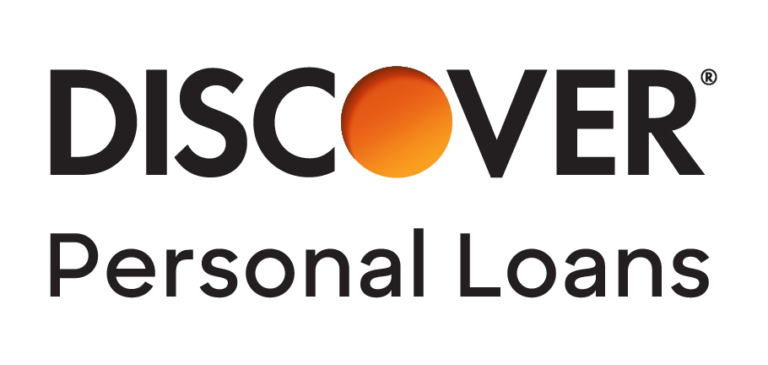
Credible Rating>
Credible lender ratings are evaluated by our editorial team with the help of our loan operations team. The rating criteria for lenders encompass 78 data points spanning interest rates, loan terms, eligibility requirement transparency, repayment options, fees, discounts, customer service, cosigner options, and more. Read our full methodology.
View details>
5.99% – 24.99% APR$2,500 to $35,0003, 4, 5, 6, 7As soon as the next business day after acceptanceFixed APR:
5.99% – 24.99% APRMin. credit score:
660Loan amount:
$2,500 to $35,000Loan terms (years):
3, 4, 5, 6, 7Time to fund:
As soon as the next business day after acceptanceFees:
Late feeDiscounts:
NoneEligibility:
Available in all 50 statesCustomer service:
PhoneSoft credit check:
YesLoan Uses:
Auto repair, credit card refinancing, debt consolidation, home remodel or repair, major purchase, medical expenses, taxes, vacation, and wedding

Credible Rating>
Credible lender ratings are evaluated by our editorial team with the help of our loan operations team. The rating criteria for lenders encompass 78 data points spanning interest rates, loan terms, eligibility requirement transparency, repayment options, fees, discounts, customer service, cosigner options, and more. Read our full methodology.
View details>
7.99% – 29.99% APR$10,000 to $50,0002, 3, 4, 5As soon as 2 business daysFixed APR:
7.99% – 29.99% APRMin. credit score:
Does not discloseLoan amount:
$10,000 to $50,000Loan terms (years):
2, 3, 4, 5Time to fund:
As soon as 2 business daysFees:
Origination feeDiscounts:
NoEligibility:
Available in all states except CO, CT, HI, KS, NH, NY, ND, OR, VT, WV, WI, and WYCustomer service:
PhoneSoft credit check:
YesMin. Income:
NoneLoan Uses:
Debt consolidation, home improvement, wedding, travel, medical expenses, and other purposes

Credible Rating>
Credible lender ratings are evaluated by our editorial team with the help of our loan operations team. The rating criteria for lenders encompass 78 data points spanning interest rates, loan terms, eligibility requirement transparency, repayment options, fees, discounts, customer service, cosigner options, and more. Read our full methodology.
View details>
7.04% – 35.89% APR$1,000 to $40,0003, 5Usually takes about 2 daysFixed APR:
7.04% – 35.89% APRMin. credit score:
600Loan amount:
$1,000 to $40,000Loan terms (years):
3, 5Time to fund:
Usually takes about 2 daysFees:
Origination feeDiscounts:
NoneEligibility:
Available in all 50 statesCustomer service:
Phone, emailSoft credit check:
YesLoan servicer:
LendingClub BankMin. Income:
NoneLoan Uses:
Debt consolidation, paying off credit cards, home improvement, pool loans, vacations, and other purposes
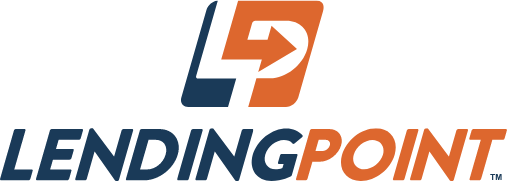
Credible Rating>
Credible lender ratings are evaluated by our editorial team with the help of our loan operations team. The rating criteria for lenders encompass 78 data points spanning interest rates, loan terms, eligibility requirement transparency, repayment options, fees, discounts, customer service, cosigner options, and more. Read our full methodology.
View details>
9.99% – 35.99% APR$2,000 to $36,5002, 3, 4As soon as the next business dayFixed APR:
9.99% – 35.99% APRMin. credit score:
580Loan amount:
$2,000 to $36,500Loan terms (years):
2, 3, 4Time to fund:
As soon as the next business dayFees:
Origination feeDiscounts:
AutopayEligibility:
Available in all states except NV and WVCustomer service:
Phone, emailSoft credit check:
YesMin. Income:
$20,000Loan Uses:
Home improvement, consolidate debt, credit card refinancing, relocate, make a large purchase, and other purposes

Credible Rating>
Credible lender ratings are evaluated by our editorial team with the help of our loan operations team. The rating criteria for lenders encompass 78 data points spanning interest rates, loan terms, eligibility requirement transparency, repayment options, fees, discounts, customer service, cosigner options, and more. Read our full methodology.
View details>
2.49% – 19.99% APR$5,000 to $100,0002, 3, 4, 5, 6, 7
(up to 12 years for home improvement loans)As soon as the same business dayFixed APR:
2.49% – 19.99% APRMin. credit score:
660Loan amount:
$5,000 to $100,000Loan terms (years):
2, 3, 4, 5, 6, 7*Time to fund:
As soon as the same business dayFees:
NoneDiscounts:
AutopayEligibility:
Available in all states except RI and VTCustomer service:
Phone, emailSoft credit check:
NoLoan servicer:
LightStreamMin. Income:
Does not discloseLoan Uses:
Credit card refinancing, debt consolidation, home improvement, and other purposes
Credible Rating>
Credible lender ratings are evaluated by our editorial team with the help of our loan operations team. The rating criteria for lenders encompass 78 data points spanning interest rates, loan terms, eligibility requirement transparency, repayment options, fees, discounts, customer service, cosigner options, and more. Read our full methodology.
View details>
6.99% – 19.99% APR1$3,500 to $40,00023, 4, 5, 6, 7Many Marcus customers receive funds in as little as three daysFixed APR:
6.99% – 19.99% APR1Min. credit score:
660
(TransUnion FICO®️ Score 9)Loan amount:
$3,500 to $40,0002Loan terms (years):
3, 4, 5, 6Time to fund:
Many Marcus customers receive funds in as little as three daysFees:
NoneDiscounts:
AutopayEligibility:
Available in all 50 statesCustomer service:
PhoneSoft credit check:
YesLoan servicer:
Goldman SachsMin. Income:
$30,000Loan Uses:
Credit card refinancing, debt consolidation, home improvement, major purchase, and other purposes
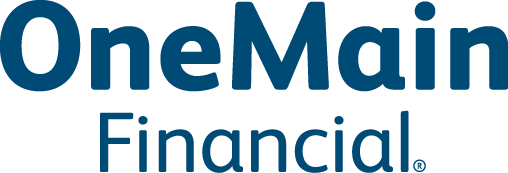
Credible Rating>
Credible lender ratings are evaluated by our editorial team with the help of our loan operations team. The rating criteria for lenders encompass 78 data points spanning interest rates, loan terms, eligibility requirement transparency, repayment options, fees, discounts, customer service, cosigner options, and more. Read our full methodology.
View details>
18.0% – 35.99% APR$1,500 to $20,0002, 3, 4, 5As soon as the same day, but usually requires a visit to a branch officeFixed APR:
18.0% – 35.99% APRMin. credit score:
NoneLoan amount:
$1,500 to $20,000Loan terms (years):
2, 3, 4, 5Time to fund:
As soon as the same day, but usually requires a visit to a branch officeFees:
Origination feeDiscounts:
NoneEligibility:
Must have photo I.D. issued by U.S. federal, state or local governmentCustomer service:
Phone, emailSoft credit check:
YesMin. Income:
Does not disclose

Credible Rating>
Credible lender ratings are evaluated by our editorial team with the help of our loan operations team. The rating criteria for lenders encompass 78 data points spanning interest rates, loan terms, eligibility requirement transparency, repayment options, fees, discounts, customer service, cosigner options, and more. Read our full methodology.
View details>
4.99% – 17.99% APR$600 to $50,000
(depending on loan term)1, 2, 3, 4, 52 to 4 business days after verificationFixed APR:
4.99% – 17.99% APRMin. credit score:
660Loan amount:
$600 to $50,000*Loan terms (years):
1, 2, 3, 4, 5Time to fund:
2 to 4 business days after verificationFees:
NoneDiscounts:
NoneEligibility:
Does not discloseCustomer service:
Phone, emailSoft credit check:
NoMin. Income:
Does not discloseLoan Uses:
Debt consolidation, home improvement, transportation, medical, dental, life events

Credible Rating>
Credible lender ratings are evaluated by our editorial team with the help of our loan operations team. The rating criteria for lenders encompass 78 data points spanning interest rates, loan terms, eligibility requirement transparency, repayment options, fees, discounts, customer service, cosigner options, and more. Read our full methodology.
View details>
6.95% – 35.99% APR$2,000 to $40,0003, 5As soon as one business dayFixed APR:
6.95% – 35.99% APRMin. credit score:
640Loan amount:
$2,000 to $40,000Loan terms (years):
3, 5Time to fund:
As soon as one business dayFees:
Origination feeDiscounts:
NoneEligibility:
Available in all states except IA, ND, WVCustomer service:
Phone, emailSoft credit check:
YesMin. Income:
NoneLoan Uses:
Debt consolidation, home improvement, vehicles, small business, new baby expenses, and other purposes

Credible Rating>
Credible lender ratings are evaluated by our editorial team with the help of our loan operations team. The rating criteria for lenders encompass 78 data points spanning interest rates, loan terms, eligibility requirement transparency, repayment options, fees, discounts, customer service, cosigner options, and more. Read our full methodology.
View details>
4.74% – 19.28% APR10$5,000 to $100,0002, 3, 4, 5, 6, 73 business daysFixed APR:
4.74% – 19.28% APR10Min. credit score:
Does not discloseLoan amount:
$5,000 to $100,000Loan terms (years):
2, 3, 4, 5, 6, 7Time to fund:
3 business daysFees:
NoneDiscounts:
AutopayEligibility:
Available in all states except MSCustomer service:
Phone, emailSoft credit check:
YesMin. Income:
Does not discloseLoan Uses:
Solely for personal, family, or household uses

Credible Rating>
Credible lender ratings are evaluated by our editorial team with the help of our loan operations team. The rating criteria for lenders encompass 78 data points spanning interest rates, loan terms, eligibility requirement transparency, repayment options, fees, discounts, customer service, cosigner options, and more. Read our full methodology.
View details>
8.93% – 35.93% APR7$1,000 to $50,0003 to 5 years 8Within one day, once approved9Fixed APR:
8.93% – 35.93% APR7Min. credit score:
560Loan amount:
$1,000 to $50,000Loan terms:
3 to 5 years 8Time to fund:
Within one day, once approved9Loan types:
Debt consolidation, pay off credit cards, home improvements, unexpected expenses, home and auto repairs, weddings, and other major purchasesFees:
Origination feeDiscounts:
AutopayEligibility:
A U.S. citizen or permanent resident; not available in DC, SC, WVCustomer service:
Phone, emailSoft credit check:
Yes

Credible Rating>
Credible lender ratings are evaluated by our editorial team with the help of our loan operations team. The rating criteria for lenders encompass 78 data points spanning interest rates, loan terms, eligibility requirement transparency, repayment options, fees, discounts, customer service, cosigner options, and more. Read our full methodology.
View details>
5.94% – 35.97% APR$1,000 to $50,0002, 3, 5, 6Within a day of clearing necessary verificationsFixed APR:
5.94% – 35.97% APRMin. credit score:
560Loan amount:
$1,000 to $50,000*Loan terms (years):
2, 3, 5, 6Time to fund:
Within a day of clearing necessary verificationsFees:
Origination feeDiscounts:
AutopayEligibility:
Available in all states except West VirginiaCustomer service:
EmailSoft credit check:
YesMin. Income:
Does not discloseLoan Uses:
Debt consolidation, credit card refinancing, home improvement, and other purposes

Credible Rating>
Credible lender ratings are evaluated by our editorial team with the help of our loan operations team. The rating criteria for lenders encompass 78 data points spanning interest rates, loan terms, eligibility requirement transparency, repayment options, fees, discounts, customer service, cosigner options, and more. Read our full methodology.
View details>
4.37% – 35.99% APR4$1,000 to $50,00053 to 5 years4As fast as 1 business day6Fixed APR:
4.37% – 35.99% APR4Min. credit score:
580Loan amount:
$1,000 to $50,0005Loan terms (years):
3 to 5 years4Time to fund:
As fast as 1 business day6Fees:
Origination feeDiscounts:
NoneEligibility:
Available in all 50 statesCustomer service:
Phone, emailSoft credit check:
YesMin. Income:
$12,000Loan Uses:
Payoff credit cards, consolidate debt, take a course or bootcamp, relocate, make a large purchase, and other purposesCompare rates from these lenders without affecting your credit score. 100% free!
Compare Now
Trustpilot
All APRs reflect autopay and loyalty discounts where available | LightStream disclosure | 10SoFi Disclosures | Read more about Rates and Terms
Builder financing
Some tiny home builders offer their own financing programs, often in partnership with a third-party financial institution.
Interest rates and terms can vary widely with these options, so be sure to read the fine print carefully and ask any questions you might have to make sure you fully understand what you’re agreeing to.
Keep in mind: Some builders might require a down payment to secure financing — this could range anywhere from 10% to 20%, depending on the lender.
Learn More: Best Personal Loan Companies
Home equity loan or HELOC
If you already own a home, you might be able to tap into your home’s equity with a home equity loan or home equity line of credit (HELOC). With these options, you might be able to access 75% to 85% of your home’s equity, depending on the lender and the value of your home.
Here’s how they work:
Home equity loanLike personal loans, home equity loans are installment loans that typically come with fixed rates. Because a home equity loan is secured by your home, you’ll likely get a lower rate than you’d get on a personal loan. However, this also means you risk losing your home if you can’t make your payments.HELOCUnlike a home equity loan, a HELOC gives you access to a revolving credit line that you can repeatedly draw on and payoff — similar to a credit card. HELOCs also tend to come with variable rates, which means your rate could fluctuate with market conditions. Also remember that because your home acts as collateral for a HELOC, you risk foreclosure if you don’t keep up with your payments.How do I calculate my home’s equity? To calculate the equity in your home, you’ll subtract your current mortgage balance from your home’s current market or appraised value.
For example, if your home is worth $400,000 and you owe $300,000, then your home’s equity is $100,000.
Check Out: Personal Loan Requirements
Financing a tiny home: additional considerations
While the cost of a tiny home could be low, here are a few additional considerations to keep in mind:
Will you have to buy land?
You’ll need a place to build your home if you want a permanent structure — which means you’ll need to also purchase land. Depending on the location, this could end up being much more expensive than the actual house.
Keep in mind: If you’re thinking about buying raw, undeveloped land, then you’ll have to account for preparing the land for construction as well as getting it hooked up with water, power, and other amenities.
You’ll also need to consider local building codes and how much it will cost to make sure your dwelling is up to code. For example, some areas require that sleeping lofts in tiny homes have an automatic sprinkler system, which is another extra cost to budget for.
How will you pay for home maintenance?
Like any other home, tiny homes also come with maintenance costs. For example, you might need to service your plumbing, appliances, and other home systems. Plus, if your tiny home is on wheels, you might need to purchase and maintain a truck to haul it.
Learn More: Personal Loan Calculator: See Your Payments On a Loan
Will the home be on wheels?
If you’re planning to build or purchase a tiny home on wheels, you might be eligible for a recreational vehicle (RV) loan. Many of these loans use the RV (or tiny home) as collateral, which means you might get a lower rate compared to a standard unsecured loan.
Keep in mind: There are also lenders that offer unsecured RV loans — for example, Credible’s partner lender LightStream offers RV loans from $5,000 to $100,000 and doesn’t require collateral.
If you decide to take out a personal loan for a tiny home, remember to consider as many lenders as you can to find the right loan for your situation.
This is easy with Credible — you can compare your prequalified rates from multiple lenders in two minutes.
Ready to find your personal loan?
Credible makes it easy to find the right loan for you.
Free to use, no hidden feesOne simple form, easy to fill out and your info is protectedMore options, pick the loan option that best fits your personal needsHere for you. Our team is here to help you reach your financial goalsFind My Rate
Checking rates won’t affect your credit
Trustpilot
The post Tiny Home Financing: What Are My Loan Options? appeared first on Credible.
15 DIY Bathroom Remodeling Projects to Tackle This Winter
If you’re a homeowner, you’ve probably got a long list of home improvement projects to tackle. While bringing your home up to date can increase its value, you can’t tackle everything at once. Instead, you’ll want to prioritize whether you’re doing a quick project or a full-on renovation.
Winter is a great time to update your bathroom. For one, it’s an indoor project, so you won’t have to deal with the cold. Plus, renovated bathrooms are well-known for producing a solid return on investment. It can also be cost-effective to start a project in the winter, since prices for materials usually rise in the early spring.
Here are 15 DIY bathroom projects to tackle this season:
Update the lightingAdd a splash of tileWallpaper the roomUpdate the vanityRecycle furniture for a new vanityInstall a towel warmerReplace the mirrorSwap out the hardwareAdd wall storageInstall eco-friendly featuresPaint the wallsImprove your shower spaceAdd window treatmentsReplace your bathroom exhaust fanAdd to your cabinet storage
1. Update the lighting

Changing an outdated light fixture can spruce up your bathroom by making it appear brighter and fresher. A hanging fixture, for instance, can add some much-needed personality, or you can install the fixture above the mirror to reflect light around the room.
This project involves temporarily disconnecting the electricity and working with wiring, so you may want to hire an expert if you’re uncomfortable with this part.
2. Add a splash of tile
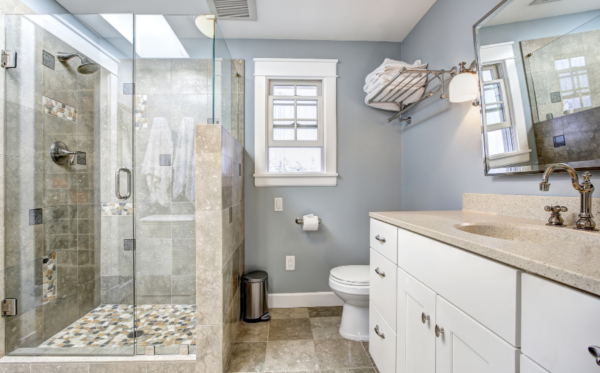
Adding tile is a great way to modernize the bathroom without a complete overhaul. It’s also easy to clean, durable, and moisture-resistant — and there are lots of options.
You may decide to re-tile the floor, install tile halfway up the shower walls, or lay a simple backsplash above the sink. White subway tiles are classic, but you can get creative by arranging them in a herringbone or chevron design, or using a hexagon- or honeycomb-shaped tile.
3. Wallpaper the room
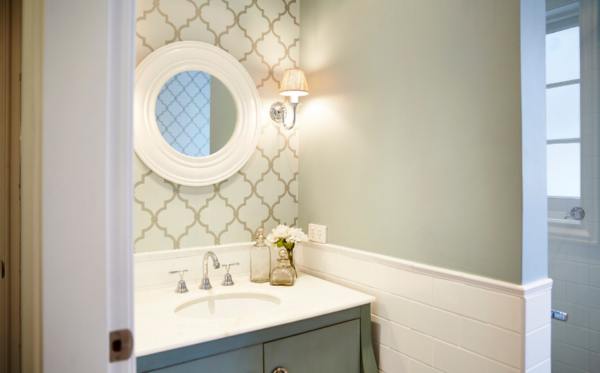
Wallpaper can add an upscale look to your powder room, whether you cover the whole thing or only apply it to one accent wall to create a focal point.
Look for “splash-proof” wallpaper, which is designed for high-humidity areas and won’t peel off as easily as regular wallpaper. You can also experiment with bold colors or patterns to create a statement.
Learn More: 18 Home Improvement Projects You Can Wrap Up in a Day
4. Update the vanity
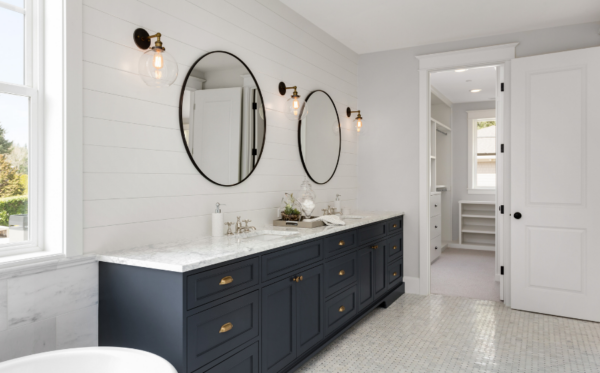
The vanity is a great place to keep your bathroom necessities organized and out of sight, and it’s also a spot where you can add some personality.
Try painting the vanity a bold new color, installing new hardware, or using painted stencils or wallpaper on the door panels. You can also replace the top with a butcher block or granite countertop for a stylish look.
5. Recycle furniture for a new vanity

If you want to swap out the vanity completely, look for upcycled furniture to repurpose. An old dresser, nightstand, or coffee table can easily be transformed into your new bathroom organization system. You can add a fresh coat of paint and new hardware, then cut a hole on the top for a sink.
Tip: Remember to moisture-proof the counter with a few coats of clear polyurethane.
6. Install a towel warmer

If you live in a colder climate, you’ll want to stay extra toasty when getting out of the shower. A wall-mounted towel warmer keeps your towels warm and can give any bathroom a luxurious feel. Towel warmers are easy to install and typically plug into a standard outlet.
7. Replace the mirror

Replacing a frameless, rectangular mirror with a more artful version can spruce up your bathroom easily. These come in different shapes, colors, and patterns to give your bathroom a style all your own.
When exploring your options online or in a store, look for a mirror that fits the space well and comes with a hanger bracket for easy installation. For a cheaper and easier project, you can keep the original mirror and get a kit to add the frame.
8. Swap out the hardware

Sometimes accent features are all you need to make a bathroom feel brand new. Replacing the faucets, towel rack, shower head, light fixtures, and toilet paper holder are easy and budget-friendly projects to tackle in the winter.
You can go for a classic look, like brushed nickel, or use a funky design from an antique store. The point is to create a unified suite to tie the room together.
Check Out: 8 Popular Pandemic Home Renovations to Transform Your Space
9. Add wall storage

If your bathroom is a tight squeeze, you might need to get creative with storage solutions. You can install floating shelves or a wall cabinet above the toilet and add a bar with hooks next to the tub — so your towel is always at the ready. If you can’t hang anything on the walls, try positioning a storage ladder over the toilet and use it to store your bathroom necessities.
10. Install eco-friendly features

Installing energy-efficient features throughout your home may help you save on utility bills while helping the planet at the same time. On top of that, high energy-efficiency ratings can boost your home value by 2.7% on average, according to research by Freddie Mac.
For a simple, DIY project, upgrade to energy-efficient lighting with halogen incandescent, CFL, or LED light bulbs. You can also install insulated windows and an Energy Star-rated toilet to further reduce your carbon footprint — but these are more complex tasks that might require a contractor.
11. Paint the walls

A fresh coat of paint isn’t usually considered a “remodel,” but using the right color may boost your resale value. A warm, neutral color can help the bathroom appear cleaner and brighter. Or, for something different, you can use painted stencils for a flourish along the trim.
12. Improve your shower space

If your shower doesn’t have enough storage for your family’s soaps and shampoos, shower shelves can be a great addition. Corner shelves are popular, or you can install a wire caddy or build a recessed shelf into the wall.
It’s possible to add these features even if your shower is tiled, using water-resistant adhesive or screws and a lightweight material for the shelf.
13. Add window treatments

Installing new blinds can help make the bathroom feel new and even improve energy-efficiency. Closing the blinds to keep heat out in the summer might cut down on cooling costs. And in the cooler months, you can open the blinds to use natural light and keep utility costs down. Curtains also add a pop of color to an otherwise neutral bathroom.
See: 15 Home Improvement Projects to Complete Before You List Your Home
14. Replace your bathroom exhaust fan

Though you may never think about your bathroom’s exhaust fan, it’s an important part of your home’s ventilation system. These remove heat, odors, and moisture from the bathroom — helping to prevent mold and improve your air quality.
Exhaust fans usually last about 10 years. If you’re not sure when it was last replaced, it’s a smart idea to invest in a new one.
15. Add to your cabinet storage

If you’re looking for ways to maximize your storage space, consider adding static or slide-out shelves to your cabinets. You can use baskets to further organize your bathroom necessities and store extras like linens and towels. These shelves come premade at hardware stores, but you might be able to reuse parts from an old dresser or vanity.
When you’re planning out your bathroom update, you may decide to tackle just a few of these projects or put all of them on your to-do list. You’ll need to consider what your bathroom needs, your budget, and how much time you have. The good news is, they’re generally easy to do by yourself or with a partner.
If you’re doing extensive remodeling to your home and need a way to fund all of the projects, you may want to consider a cash-out refinance. With a cash-out refinance, you’ll replace your existing mortgage with a newer, larger mortgage and receive the difference as a lump sum. Credible can help you find a great rate on a cash-out refinance in just a few minutes.
Get the cash you need and the rate you deserve
Compare lendersGet cash out to pay off high-interest debtPrequalify in just 3 minutesFind My Loan
No annoying calls or emails from lenders!
Trustpilot
The post 15 DIY Bathroom Remodeling Projects to Tackle This Winter appeared first on Credible.




